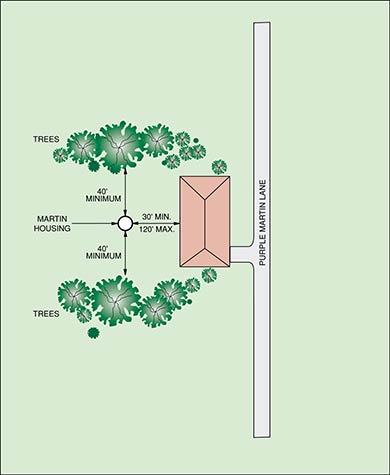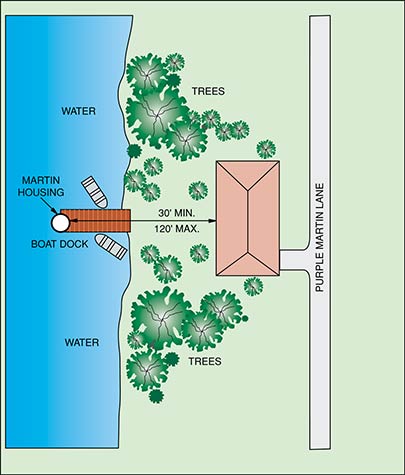 The most
important thing you can do to attract purple martins is place your
house or gourds in the most wide open area of your property. The more open the site, the better your
chances are of attracting martins so now is a good time to cut back bushes or
trees that interfere with the martins’ flyways. As one landlord on the PMCA forum once put it, "martins prefer to land like an airplane, not a helicopter". When taking off from their housing, martins often launch themselves, drop down, then fly up. When returning to their housing, they will drop down, then swoop up to their housing. It's actually a very distinct flying trait that helps me identify them in flight when I don't have my glasses on, from other black birds.The PMCA site recommends at least 40 feet of wide open area around your housing, but the more you have the better your chances.
The most
important thing you can do to attract purple martins is place your
house or gourds in the most wide open area of your property. The more open the site, the better your
chances are of attracting martins so now is a good time to cut back bushes or
trees that interfere with the martins’ flyways. As one landlord on the PMCA forum once put it, "martins prefer to land like an airplane, not a helicopter". When taking off from their housing, martins often launch themselves, drop down, then fly up. When returning to their housing, they will drop down, then swoop up to their housing. It's actually a very distinct flying trait that helps me identify them in flight when I don't have my glasses on, from other black birds.The PMCA site recommends at least 40 feet of wide open area around your housing, but the more you have the better your chances. Trees that are too close to your housing also provide hawks and other predators with cover from which they can launch surprise attacks on your martin colony. It seems that martins are well aware of these potential threats. As martins only breed and raise young once per year, it is imperative that they select the most safe, protected site they can find for that one shot.
For landlords that are new to purple martins this year, if your housing is located in a wide open area, then try some of these additional techniques to increase your chances this year:
- Make
pre-made nests for each of your nesting cavities using Eastern white pine
needles (do not use the pine needles that hurt when you crush it in your
hand – that is called “short leaf” pine).
Usually 2 to 3 good fistfuls will suffice in the nest cavity. If you are unable to find white pine
needles, some alternatives for nesting materials are wheat straw, dry
aspen shavings, corn fodder (shredded corn husks) etc. I prefer the white pine needles or corn
fodder as these materials are not likely to soak up and hold water. Cold, wet nests can be deadly to bird
nestlings.
- After
making the nests, smear some mud around the entrance holes to make the
nest cavity look “used”. Most
martins will build a mud “dam” at the front of their nesting cavity.
- Add perches
to your house. Martins are a bit
wary of new sites and adding perching rods either on your housing or on a
separate perching station will help them to feel safe while observing your
house or gourds for their potential new families.

Four foot garden stakes can be purchased at any local store and added to the railings of your housing with a couple of zip ties.
- Throw
out oyster shells or prepared egg shells on a bare spot on the ground** away
from shrubbery or in a tray mounted on a pole near the housing. Lots of other birds, such as tree
swallows, barn swallows and blue birds will also benefit from the calcium. Please note - after attracting purple martins using this method, move the calcium offerings up to a raised platform where the birds will be safer (they are slow to take off from the ground if a hawk attacks).
- Play
the dawnsong cd (you can order the Dawnsong CD from the Purple Martin Conservation
Association (PMCA)). Click here to order:
https://www.purplemartin.org/shop/product/chat/purple-martin-daytime-chatter-cd/ - Place
a couple of martin decoys on your housing.
**Note: Some martins
may not like this and may act very wary around the decoy, but on the other
hand, some martins snuggle right up to the decoy – but don’t worry, the
relationship will be short-lived.
Observe your new arrivals to determine their reaction to your
decoys, then decide whether you should remove them or not. Decoys can also help protect your
martins during hawk or owl attacks.
- Do not
allow native cavity nesting birds to take over your martin housing. If native birds (blue birds, tree
swallows, wrens, etc.) are trying to take over your martin housing, close
your martin housing and put up suitable housing for these cavity nesters
25 to 35 feet away from your purple martin housing. Once they have accepted the other
housing, then you may open your martin housing. CAUTION:
It is illegal to remove a native bird’s nest once they have laid
eggs so make sure you move the birds out early!
If the bluebirds or tree swallows persist, then go to this link to read more about directing them to their own nestboxes: http://www.drugfreeworkplace.com/~Dan/TRIHABITATION/TSEMERGENCY.html
The presence of bluebirds and tree swallows in your yard is actually an excellent indicator that you have created a bird-friendly yard! Also, these birds should not be discouraged from nesting in your yard in their own appropriate housing. In fact, bluebirds, tree swallows and purple martins have somewhat of a symbiotic relationship. Bluebirds and tree swallows nesting in your yard can provide an early warning system, sounding an alarm call when a predator such as a hawk or cat is nearby, quickly flushing all the birds into the air to safety.
 |
| Photo by Larry Melcher, Member Extraordonaire - PMCA |
- Eliminate non-native nest cavity competitors immediately. English house sparrows and starlings are not native to this country and are not protected. If a house sparrow finds your house or gourds, he will set up territory and run off the more docile young martins that try to nest there. I know I keep repeating this in every article and newsletter I publish, but it is hard to over stress how important this step is to having a successful martin colony. Re-read this blog post on dealing with the non-native birds. http://kathyfreeze.blogspot.com/2014/02/english-house-sparrows-and-starlings.html
To test your knowledge of Purple Martins, here are some fun March Trivia Questions (submit your answers in the comments section below - I'll provide the correct answers in my next post):
- Purple Martins normally migrate south at the end of their nesting season to what country?
- Cuba
- Mexico
- Brazil
- Puerto Rico
- On average, how long does a martin live?
- 10-12 years
- 2-5 years
- 15-17 years
- More than 20 years
- How far can a purple martin fly in one day?
- 358 miles
- 93 miles
- 150 miles
- 229 miles
- The purple martin is a member of which bird family?
- Finch
- Raptor
- Gnateater
- Swallow
- Which of the following reasons may cause you to not attract or lose your martins?
- A pair of English house sparrows have built a nest in one of the compartments
- Your purple martin house is enclosed by trees within 10 feet of your housing.
- You conducted a nest check last year and touched the martins’ babies.
- A snake climbed your pole and ate an adult pair and their 5 babies.




